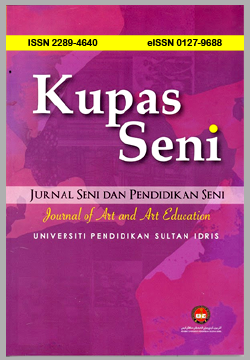An Aesthetic Study on Traditional Batik Design of Miao Ethnicity in China
DOI:
https://doi.org/10.37134/kupasseni.vol9.2.2.2021Keywords:
Danzhai Miao, traditional batik, process, patterns, aesthetic studyAbstract
As an ancient folk art, batik has a production history of more than two thousand years in the world. In China, batik is mainly concentrated in the minority areas of southwestern, such as Guizhou, Yunnan, Hunan Province. The Miao batik art has rich patterns and profound cultural implications. At the same time, it has strong regional characteristics and national personality, showing the historical changes, cultural customs, and aesthetic ideas of Miao people. Danzhai is known as the “land of batik”, and the batik pattern is different from other batik types by its primitive and uninhibited style. This research introduces the history, special technological process, typical patterns, and aesthetic study of traditional Miao batik in Danzhai. And the purpose of this study is to discover the aesthetic characteristics of Danzhai Miao batik.
Downloads
References
Bo, H. (2014). Study on the Batik Patterns and Crafts of the Miao Costumes in Northwestern Guizhou Province. 2nd International Conference on Advances in Social Science, Humanities, and Management (ASSHM-14), 250–254.
Chen, J., & Zhao, L. (2015). The Artistic Charm of Bird Totem of Hmong in Danzhai. Chinese Traditional Culture.3 (3), Pg.36.
Chen, W. J. (1984). History of Textile Science and Technology in Ancient China. Beijing: Science Press.
Daoling Chen., & Pengpeng Cheng. (2021). A Method to Extract Batik Fabric Pattern and Elements, The Journal of The Textile Institute, 112:7, 1093-1099, DOI: 10.1080/00405000.2020.1802885.
Dong Han., & Linlin Cong. (2021). Miao Traditional Patterns: The Origins and Design Transformation, International Visual Sociology Association, Visual Studies, DOI: 10.1080/1472586X.2021.1940261.
Dongchang Zhao., & Feng Liu. (2021). Indigenous Forest Knowledge (IFK) and Nature Reserve Workers’ Perceptions of IFK: A Case Study of Leigongshan National Nature Reserve, China, Journal of Sustainable Forestry, DOI: 10.1080/10549811.2021.1906282.
Gao, K., Han, H., & Gao, H. (2010). The Formation and Evolution of the Guizhou Traditional Batik Arts in the Perspective of Cultural Ecology. Journal of Guizhou University (Art Edition), 1, Pg.91–95.
He, C. (2006). Miaozu laran. Miao Batik. [Batik of Miao Nationality] Yunnan daxue chubanshe, ISBN 9787811121339, Pg.139-150.
He, C., & Yang, W. (2009). Guizhou laran. [Guizhou Batik]. Suzhou University edition,ISBN 9787811374230,Pg.29,P130.
Jia, J. (2010). Laran yishu sheji jiaocheng [Batik art design course]. Qinghua daxue chubanshe. ISBN 9787302217893, Pg.136.
Li, Shan. (2019). Discussion on batik pattern of Miao nationality in Danzhai of Guizhou Province. Journal of Home Drama, 30, Pg.128.
Lei, L., & Xiang, Z. (2014). Miaozu chuantong laran de xianzhuang yu banhuduice[The Current Situations and Protection Measures of Miao Nationality Batik]. Wenshan Xueyuan Xuebao, 27(1), 27–30.
Lu, S., & Pan, D. (2019). Chuantong laran yu xiandai gongyi de ronghe. The fusion of traditional batik and modern technology. Siwang Yinshua, 02, Pg.23–30.
Liu, Jia., & Wang, Qunshan. (2017). Application and change of butterfly pattern in Miao art. Design, 12, Pg.104.
Liu,Yong. (2018). The artistic characteristics and cultural connotation of Guizhou Dandu batik. Journal of Folkart, 01, Pg. 78-79.
Ma, Z. (2010). Guizhou laran. [Guizhou Batik]. Guizhou minzu chubanshe.ISBN 9787541210617, Pg.5.
Shi, Y., Zhang, L., & Wang, L. (2021). Quality Blues: Traditional Knowledge Used for Natural Indigo Identification in Southern China. J Ethnobiology Ethnomedicine 17. https://doi.org/10.1186/s13002-021-00454-z
Xiong, H. (2016). The design and application of heterogeneous isomorphism traditional batik pattern. International Conference on Advances in Mechanical Engineering & Industrial Informatics.Pg. 309.
Yang, C. (1997). Miao fushi: fuhao yu xiangzheng [Dress Oramentation - A Special Cultural Symbol]. In Guizhou People Press.ISBN 7221040915, Pg.154-155.
Yiying Liu., & Young Chun Ko. (2021). Research on Inheritance Education of Miao Batik. Journal of Frontiers in Educational Research Clausius Scientific Press, Canada Volume 1, Number 3. Pg. 51-63.
Yong Ma., Dongyang Liu., Hong Cheng., Rainer W. Bussmann., Huajie He, Zhiyong Guo., & Bo Liu. (2019). Ethnobotanical Study of Medicinal Plants Used by Miao People in Jijiezi, Yunnan, China. A Journal of Plants, People and Applied Research. Ethnobotany Research and Application. Pg 1-14
Yu Meng, Jongmyoung Choi., & Jiyoung Kim. (2018). A comparative study on Chinese batik of Miao and Buyi in GuiZhouSheng. The Research Journal of the Costume Culture. Vol.26, No.4, Pg.531-546.
Zhang, Huan., & Tian, Xin. (2019). Batik process and artistic features of the Miao nationality in Danzhai. Journal of Textile Auxiliaries,Vol. 36, No.1,Pg.10-11.
Zhengfu Chena., Xiaodong Ren., & Zaijie Zhang. (2021). Cultural Heritage as Rural Economic Development: Batik Production Amongst China’s Miao Population. Journal of Rural Studies 81. Pg.182–193.





